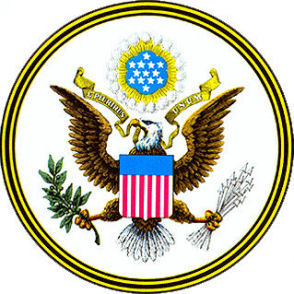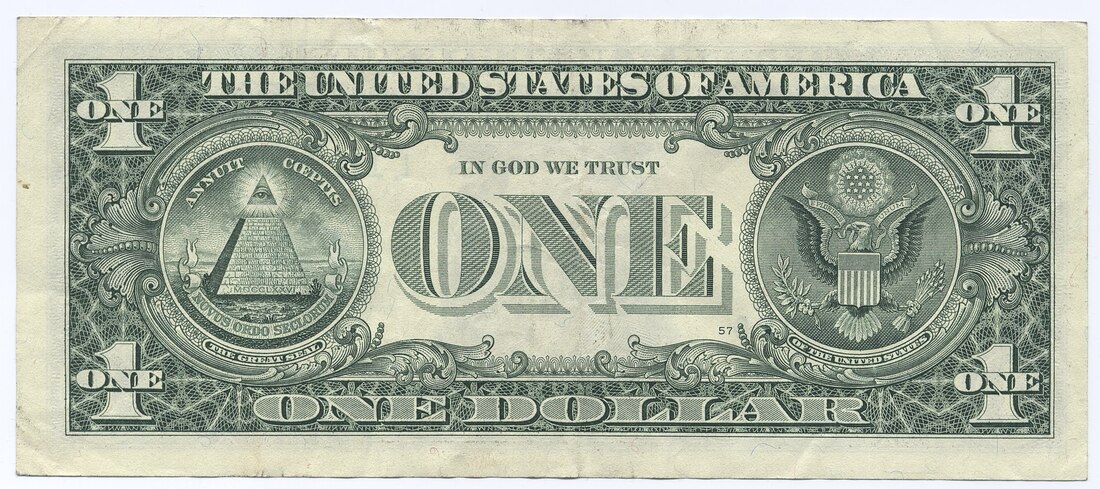Ontcijferen van de 1 dollar biljet

Armen: Paleways van 13 stuks, argent en gules; escutcheon op de borst van de Amerikaanse [ Kale] adelaar toonde juist, met in zijn dexter [rechts] talon een olijftak , en in zijn sinistere [ links ] een bundel van 13 pijlen, allemaal correct, en in zijn snavel een rol gegraveerd met het motto, " E PLURIBUS UNUM" Voor de CREST: Over het hoofd van de adelaar, die boven het schild verschijnt , een glorie, of, of breken door een wolk, juist, en het omringen van 13 sterren, het vormen van een constellatie, argent, op een azuurblauw veld. ACHTERUIT: een onvoltooide piramide. In het zenit, een oog in een driehoek, omringd door een glorie. Over het oog deze woorden, "ANNUIT COEPTIS." Op de basis van de piramide de numerieke letters MDCCLXXVI. En onder het volgende motto, "NOVUS ORDO SECLORUM" ANNUIT COEPTIS: Wat betekent dit? Onder het motto ANNUIT COEPTIS moet het onderwerp van het werkwoord worden aangeleverd en moet de vertaler ook de tijd kiezen. In 1892 werd gesuggereerd dat het ontbrekende onderwerp in feite het oog aan de top van de piramide was ... en zo werd het motto-in de tegenwoordige tijd-als "het (het Oog van Voorzienigheid) is gunstig voor onze ondernemingen." In latere publicatie werd het ontbrekende onderwerp van het werkwoord ANNUIT geïnterpreteerd als God, en het motto is vertaald in meer recente afdeling publicatie -in de perfecte tijd- als "Hij (God) heeft onze ondernemingen begunstigd". NOVUS ORDO SECLORUM: Wat betekent dit? Het motto is terug te voeren op Vergilius, de beroemde Romeinse dichter die leefde in de eerste eeuw voor Christus (Yahusha) – tot een regel in zijn Eclogue IV, het pastorale gedicht dat het verlangen van de wereld naar een nieuw tijdperk van vrede en geluk uitdrukt. Magnus ab integro seclorum nascitur ordo. Virgil's lijn is op verschillende manieren vertaald, waaronder: De grote reeks leeftijden begint opnieuw. De machtige mars van de eeuwen begint opnieuw. Een machtige orde der eeuwen wordt opnieuw geboren. De majestueuze rol van cirkelende eeuwen begint opnieuw. "Novus" betekent: nieuw, jong, fris, roman. "Ordo" betekent: serie, rij, volgorde. "Seclorum, een verkorte vorm van seculorum (sæculorum), is het meervoud van seculum (sæculum), betekent: generaties, eeuwen of leeftijden. Thomson, een Latijnse expert, bedacht het motto: "novus ordo seclorum" en legde de betekenis ervan uit: "De datum onder [de piramide] is die van de Onafhankelijkheidsverklaring en de woorden eronder betekenen het begin van de nieuwe Amerikaanse Jaartelling, die vanaf die datum begint." De officiële Engelse vertaling van "novus ordo seclorum" is: "A new order of the ages" De discussie is of "Novus ordo seclorum" "nieuwe wereldorde" betekend. Seclorum is meervoud (nieuwe wereldenorde?). En Thomson zei dat het motto verwijst naar het begin van een nieuw tijdperk – een Amerikaans tijdperk dat begint in 1776. De stijgende bouwrijen van de piramide illustreren deze nieuwe reeks generaties. Zo samen betekende de woorden het begin van de nieuwe Amerikaanse Jaartelling die vanaf die datum begon, gezien aan de voet van de Piramide.
Castings voor zeehonden werden gedaan in 1782 en 1841, maar in 1883 werd het omgekeerde officieel afgewezen door een commissie onder leiding van professor Elliot Norton van Harvard University die ondubbelzinnig zei dat het een saai embleem van de vrijmetselaarsvereniging was. Het is nooit gesneden! Verder werd het nooit echt gezien tot 1935 toen het op het dollarbiljet verscheen. Zijn de symbolen op dit zegel vrijmetselaars of hier bij toeval? Is het ons wishful thinking? Laten we deze een voor een bekijken, verwijzend naar de kopieën voor u. Laten we nadenken en overwegen of ze vrijmetselaars zijn of dat we er vrijmetselaarsvoordeel uit halen. Een punt van historisch belang.: Alvorens verder te gaan, wil ik verduidelijken dat het Grote Zegel is als een munt met twee zijden die nu op het ene $ biljet staan op aansporing van president Roosevelt in 1935; gescheiden links en rechts – de voorkant [ omgekeerd ] is aan uw rechterhand en de achterkant [ de piramide ] aan uw linkerhand. Ik wil er ook op wijzen dat het gezicht van de adelaar oorspronkelijk met de pijlen werd geconfronteerd, maar op aandringen van president Truman werd hij in 1945 omgeleid naar de olijftakken.
De adelaar heeft 32 veren op zijn rechtervleugel, het aantal gewone graden in de Schotse Rite Vrijmetselarij.
De linkervleugel heeft 33 veren, wat overeenkomt met de 33e graad van dezelfde rite die is toegekend voor uitstekende vrijmetselaarsdienst. De staartveren nummer negen – het aantal graden in Chapter, Council en Commandery of the York Rite. De Schotse Ritus vindt zijn oorsprong in Frankrijk, waar de York Rite amerikaans is, maar ook een vertegenwoordiging van de Unie van Franse en Amerikaanse metselaars in de strijd voor vrijheid, gelijkheid en broederschap.
Het totale aantal veren bedraagt 65, wat volgens gematria de waarde is van 'gam yachad' ( 3+40+10+8+4) [Psalm 133- Hinei ma tov etc] een uitdrukking die vaak in de vrijmetselarij wordt gebruikt. De glorie boven het hoofd van de adelaar is verdeeld in 24 gelijke delen die doen denken aan de 24 inch meter en is emblematisch voor de service die je elk uur van de dag moet uitvoeren. De 5-puntige ster doet je misschien denken aan de Masonic Blazing-ster en de 5 punten van gemeenschap. De opstelling van de sterren in het bovengenoemde sterrenbeeld kan overlappend zijn
Castings voor zeehonden werden gedaan in 1782 en 1841, maar in 1883 werd het omgekeerde officieel afgewezen door een commissie onder leiding van professor Elliot Norton van Harvard University die ondubbelzinnig zei dat het een saai embleem van de vrijmetselaarsvereniging was. Het is nooit gesneden! Verder werd het nooit echt gezien tot 1935 toen het op het dollarbiljet verscheen. Zijn de symbolen op dit zegel vrijmetselaars of hier bij toeval? Is het ons wishful thinking? Laten we deze een voor een bekijken, verwijzend naar de kopieën voor u. Laten we nadenken en overwegen of ze vrijmetselaars zijn of dat we er vrijmetselaarsvoordeel uit halen. Een punt van historisch belang.: Alvorens verder te gaan, wil ik verduidelijken dat het Grote Zegel is als een munt met twee zijden die nu op het ene $ biljet staan op aansporing van president Roosevelt in 1935; gescheiden links en rechts – de voorkant [ omgekeerd ] is aan uw rechterhand en de achterkant [ de piramide ] aan uw linkerhand. Ik wil er ook op wijzen dat het gezicht van de adelaar oorspronkelijk met de pijlen werd geconfronteerd, maar op aandringen van president Truman werd hij in 1945 omgeleid naar de olijftakken.
De adelaar heeft 32 veren op zijn rechtervleugel, het aantal gewone graden in de Schotse Rite Vrijmetselarij.
De linkervleugel heeft 33 veren, wat overeenkomt met de 33e graad van dezelfde rite die is toegekend voor uitstekende vrijmetselaarsdienst. De staartveren nummer negen – het aantal graden in Chapter, Council en Commandery of the York Rite. De Schotse Ritus vindt zijn oorsprong in Frankrijk, waar de York Rite amerikaans is, maar ook een vertegenwoordiging van de Unie van Franse en Amerikaanse metselaars in de strijd voor vrijheid, gelijkheid en broederschap.
Het totale aantal veren bedraagt 65, wat volgens gematria de waarde is van 'gam yachad' ( 3+40+10+8+4) [Psalm 133- Hinei ma tov etc] een uitdrukking die vaak in de vrijmetselarij wordt gebruikt. De glorie boven het hoofd van de adelaar is verdeeld in 24 gelijke delen die doen denken aan de 24 inch meter en is emblematisch voor de service die je elk uur van de dag moet uitvoeren. De 5-puntige ster doet je misschien denken aan de Masonic Blazing-ster en de 5 punten van gemeenschap. De opstelling van de sterren in het bovengenoemde sterrenbeeld kan overlappend zijn
